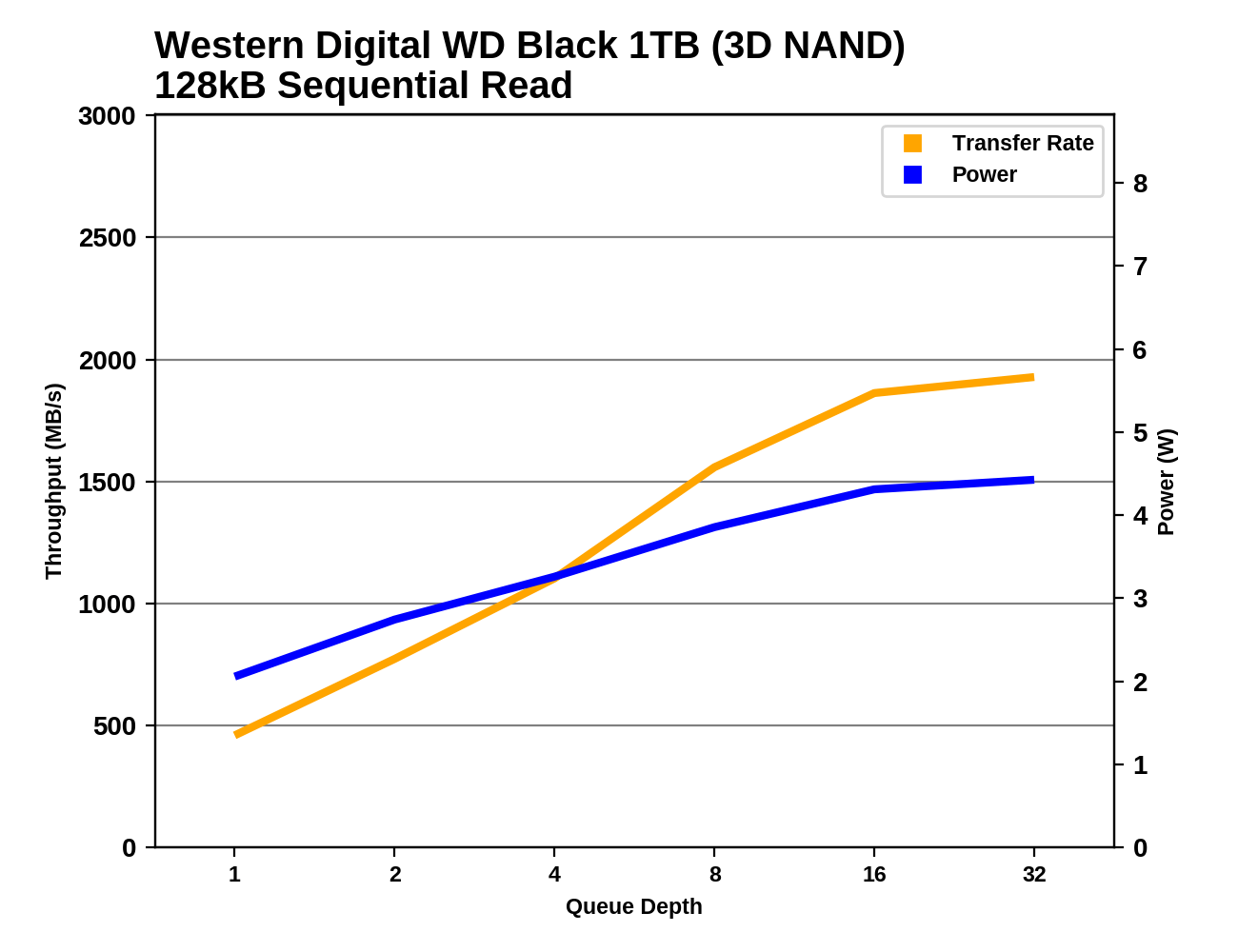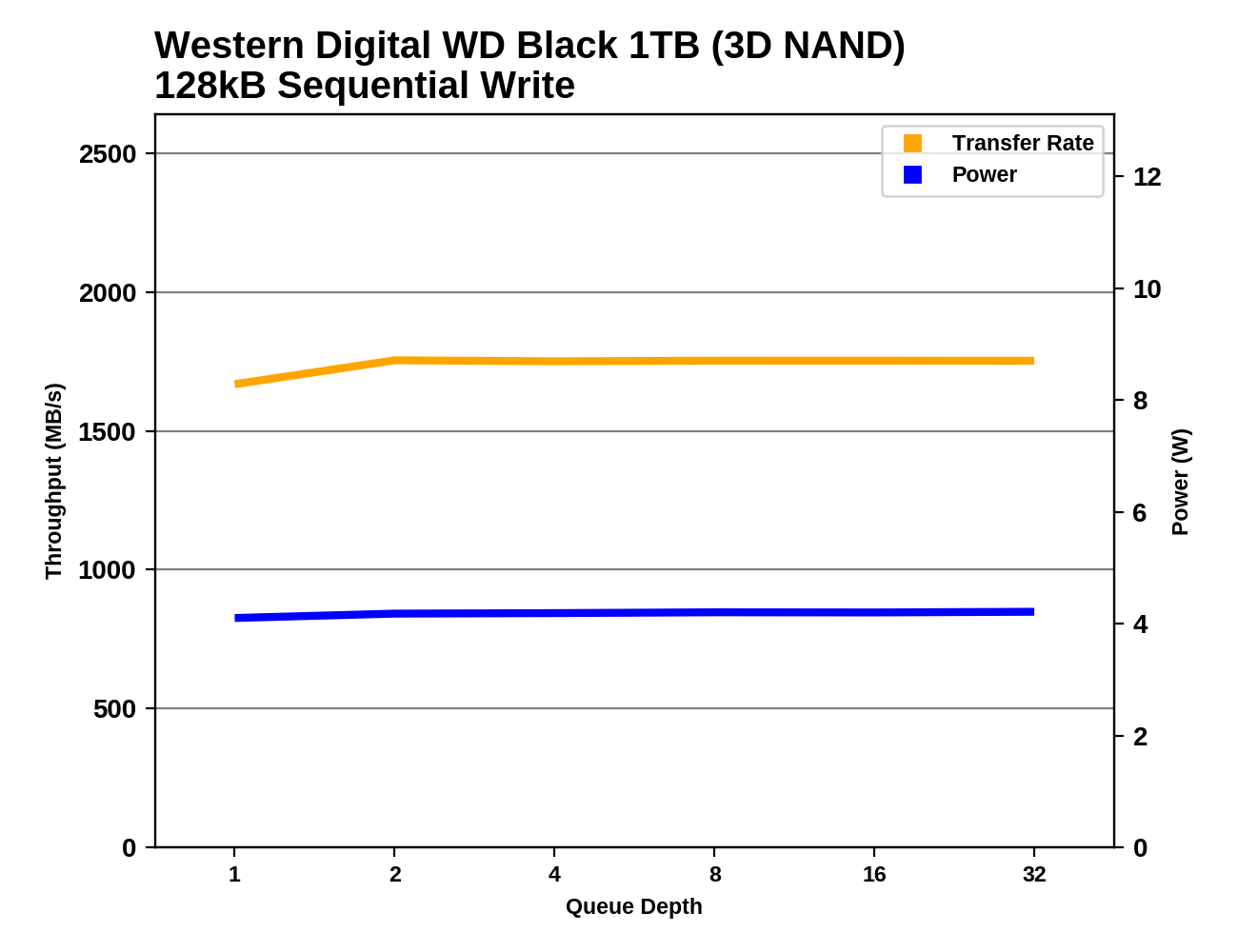The Western Digital WD Black 3D NAND SSD Review: EVO Meets Its Match
by Ganesh T S & Billy Tallis on April 5, 2018 9:45 AM EST- Posted in
- SSDs
- Storage
- Western Digital
- SanDisk
- NVMe
- Extreme Pro
- WD Black
Sequential Read Performance
Our first test of sequential read performance uses short bursts of 128MB, issued as 128kB operations with no queuing. The test averages performance across eight bursts for a total of 1GB of data transferred from a drive containing 16GB of data. Between each burst the drive is given enough idle time to keep the overall duty cycle at 20%.

The burst sequential read performance of the WD Black is several times higher than last year's model, but doesn't come close to setting any records.
Our test of sustained sequential reads uses queue depths from 1 to 32, with the performance and power scores computed as the average of QD1, QD2 and QD4. Each queue depth is tested for up to one minute or 32GB transferred, from a drive containing 64GB of data.

On the sustained sequential read test, the Samsung NVMe drives have a clear lead over the WD Black, which is tied with Toshiba's drives.
 |
|||||||||
| Power Efficiency in MB/s/W | Average Power in W | ||||||||
In terms of power efficiency for sequential reads, the WD Black is much closer to the top drives, with the exception of the Samsung 960 PRO.
 |
|||||||||
The sequential read performance of the WD Black starts out rather poor at QD1 but grows steadily all the way up to QD16, by which point it is outperforming everything except the Optane SSD. The Toshiba XG5 shows similar scaling behavior but can't quite keep pace with the WD Black.
Sequential Write Performance
Our test of sequential write burst performance is structured identically to the sequential read burst performance test save for the direction of the data transfer. Each burst writes 128MB as 128kB operations issued at QD1, for a total of 1GB of data written to a drive containing 16GB of data.

As with the burst random write test, our two samples show surprising differences in burst sequential write speeds. The difference amounts to the WD Black/SanDisk Extreme PRO either being tied for second place with the Samsung 960 EVO, or almost tied with the PM981 that the 960 EVO's replacement will be based on.
Our test of sustained sequential writes is structured identically to our sustained sequential read test, save for the direction of the data transfers. Queue depths range from 1 to 32 and each queue depth is tested for up to one minute or 32GB, followed by up to one minute of idle time for the drive to cool off and perform garbage collection. The test is confined to a 64GB span of the drive.

The sustained sequential write performance of the WD Black is not quite the best, but it is well ahead of everything except the best drives from Samsung and Intel. The WD Black is almost twice as fast as the Toshiba XG5 that uses essentially the same flash.
 |
|||||||||
| Power Efficiency in MB/s/W | Average Power in W | ||||||||
Despite not having the best performance on the sequential write test, the WD Black is the clear winner on the efficiency metric. With power draw of just over 4W it isn't close to being the least power-hungry drive, but it get so much done on that budget that the efficiency score beats everything else.
 |
|||||||||
The sequential write speed of the WD Black is quite steady across the range of queue depths, with just a small increase from QD1 to QD2 and no signs of degraded performance from excessive garbage collection after the SLC cache is full.










69 Comments
View All Comments
Mr Perfect - Friday, April 6, 2018 - link
On one hand I appreciate having a mechanical in the charts to see how these SSDs compare, since it's a great way to show the benefits of upgrading to one. On the other hand it makes the SSD results really hard to read, as they become disappearingly small. Hopefully one day we won't have to show people the difference.Billy Tallis - Friday, April 6, 2018 - link
It's not something I plan to include in most reviews. I only added it for this one because the mechanical drive I happened to have on hand to benchmark was also a 1TB WD Black. On a lot of reviews, I leave out Optane drives for the same reasons.amar.znzi - Friday, April 6, 2018 - link
> The new controller has a tri-core architecture (probably using Arm Cortex-R cores) fabricated in a 28nm process.Please don't speculate. Can you confirm with WD which Instruction Set Architecture is being used?
Billy Tallis - Sunday, April 8, 2018 - link
We asked repeatedly, and all we could get was that it isn't RISC-V. But every other NVMe controller used in consumer SSDs uses Cortex-R, and there's no reason to suspect WD is doing anything different. There aren't many alternatives. They designed this controller architecture to put as much of the important functionality on dedicated hardware as possible, so doing something unusual with the CPU cores doesn't present much opportunity for improving performance or efficiency.Klimax - Sunday, April 8, 2018 - link
Maybe ARC. (Intel uses it for some of their MEs)amar.znzi - Saturday, April 14, 2018 - link
Oh, it's not. WD has anounced that it intends to transition a large volume of it's products to RISC-V. Thanks, that answered my question.HStewart - Sunday, April 8, 2018 - link
One question, I have is there any real advantage of using this model version cheaper model - in an USB-C Gen 2 case?SanX - Sunday, April 8, 2018 - link
Which tasks will benefit from fast drives and which will not in real life ? Will Antivirus full clean go faster then 3-4 days currently? Or archieving? Or search for file with specific content? Having 10x read speed will loading Windows go 10x faster then with neanderthal mechanical Western Digital Gold hard drives or only by mere 10%? That what I like to see as tests not that semi-nonsence which resembles proverbial fake news of political media.Good would be to see the temperature map on a heavy load, the 10, 13 and even on some drives 20 Watts for such small formfactor is a lot.
Also I still keep for history some old hard drives which don't giveup their life after 30 years. Will these new ones with guaranteed 5 years then disintegrate after 10?
MajGenRelativity - Tuesday, April 10, 2018 - link
Most people don't keep their hard drives for 30 years, as the interface connector is far obsolete by now. I'm not even certain that IDE/PATA goes back that far, and you'd most likely need a highly specialized product to even read/write to that drive. 10 years for an SSD is a reasonable lifespan, as you'd probably upgrade to something faster or denser after that time.Rami Meir - Thursday, April 12, 2018 - link
I would like to see:1. 2TB 2280 and 4TB 22110
2. IOPS performance @ QD=1
P.S. SW Drivers available at www.nvmexpress.org
Warranty period directly calculated based on the Endurance fures